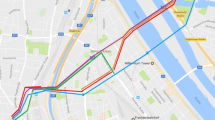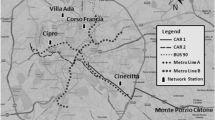Abstract
Commuting in urban environments accounts for a large fraction of the daily dose of inhaled air pollutants, especially in countries where vehicles have old technologies or run on dirty fuels. We measured black carbon (BC) concentrations during bus, walk and bicycle commutes in a Brazilian city and found a large spatial variability across the surveyed area, with median values between 2.5 and 12.0 μg m−3. Traffic volume on roadways (especially the number of heavy-duty diesel vehicles), self-pollution from the bus tailpipe, number of stops along the route and displacement speed were the main drivers of air pollution on the buses. BC concentrations increased abruptly at or close to traffic signals and bus stops, causing in-cabin peaks as large as 60.0 μg m−3. BC hotspots for the walk mode coincided with the locations of bus stops and traffic signals, whilst measurements along a cycle lane located 12 m from the kerb were less affected. The median BC concentrations of the two active modes were significantly lower than the concentrations inside the bus, with a bus/walk and bus/bicycle ratios of up to 6. However, the greater inhalation rates of cyclist and pedestrians yielded larger doses (2.6 and 3.5 μg on a 1.5-km commute), suggesting that the greater physical effort during the active commute may outweigh the reduction in exposure due to the shift from passive to active transport modes.







Similar content being viewed by others
References
Adams HS, Nieuwenhuijsen MJ, Colvile RN, McMulle MA, Khandelwal P (2001) Fine particle (PM2.5) personal exposure levels in transport microenvironments, London, UK. Sci Total Environ 279:29–44
Alm S, Jantunen MJ, Vartiainen M (1999) Urban commuter exposure to particle matter and carbon monoxide inside an automobile. J Expo Anal Environ Epidemiol 9(3):237–244
Betancourt RM, Galvis B, Balachandran S, Ramos-Bonilla JP, Sarmiento OL, Gallo-Murcia SM, Contreras Y (2017) Exposure to fine particulate, black carbon, and particle number concentration in transportation microenvironments. Atmos Environ 157:135–145
Bigazzi AY, Figliozzi MA (2014) Review of urban bicyclists' intake and uptake of traffic-related air pollution. Transp Rev 34:221–245
Böcker L, Dijst M, Faber J (2016) Weather, transport mode choices and emotional travel experiences. Transp Res A 94:360–373
Bond TC, Doherty SJ, Fahey DW, Forster PM, Berntsen T, DeAngelo BJ, Flanner MG, Ghan S, Kärcher B, Koch D, Kinne S, Kondo Y, Quinn PK, Sarofim MC, Schultz MG, Schulz M, Venkataraman C, Zhang H, Zhang S, Bellouin N, Guttikunda SK, Hopke PK, Jacobson MZ, Kaiser JW, Klimont Z, Lohmann U, Schwarz JP, Shindell D, Storelvmo T, Warren SG, Zender CS (2013) Bounding the role of black carbon in the climate system: a bounding the role of black carbon in the climate system: a scientific assessment. J Geophys Res 118:5380–5552
Buehler R (2011) Determinants of transport mode choice: a comparison of Germany and the USA. J Transp Geogr 19:644–657
Bullard RD, Wright BH (1993) Environmental justice for all: community perspectives on health and research needs. Toxicol Ind Health 9:821–841
Brantley HL, Hagler GSW, Kimbrough ES, Williams RW, Mukerjee S, Neas LM (2015) Mobile air monitoring data-processing strategies and effects on spatial air pollution trends. Atmos Meas Tech 7:2169–2183
CAF Observatorio de Movilidad Urbana para América Latina (2009) Información para mejores políticas y mejores ciudades. http://scioteca.caf.com/handle/123456789/422. Accessed 25 July 2017
Carvalho AM (2017) Monitoramento da exposição pessoal ao poluente atmosférico black carbon. Dissertation (in Portuguese), Universidade Tecnológica Federal do Paraná
Cepeda M, Schoufour J, Freak-Poli R, Koolhaas CM, Dhana K, Bramer WM, Franco OH (2017) Levels of ambient air pollution according to mode of transport: a systematic review. Lancet. https://doi.org/10.1016/S2468-2667(16)30021-4
Creemers L, Wets G, Cools M (2015) Meteorological variation in daily travel behaviour: evidence from revealed preference data from the Netherlands. Theoret Appl Climatol 120:183–194
de Nazelle A, Fruin S, Westerdahl D, Martinez D, Ripoll A, Kubesch N, Nieuwenhuijsen M (2012) A travel mode comparison of commuters’ exposures to air pollutants in Barcelona. Atmos Environ 59:151–159
de Nazelle A, Bode O, Orjuela JP (2016) Comparison of air pollution exposures in active vs. passive travel modes in European cities: a quantitative review. Environ Int. https://doi.org/10.1016/j.envint.2016.12.023
Dons E, Panis LI, van Poppel M, Wets G (2012) Personal exposure to black carbon in transport microenvironments. Atmos Environ 55:392–398
EPA: Exposure factors handbook (2011) http://www.epa.gov/ncea/efh. Accessed 25 July 2017
Fleischman R, Amiel R, Czerwinski J, Mayer A, Tartakovsky L (2017) Buses retrofitting with diesel particle filters: real-world fuel. J Environ Sci. https://doi.org/10.1016/j.jes.2017.09.011
Fondelli MC, Chellini E, Yli-Tuomi T, Cenni I, Gasparrini A, Nava S, Garcia-Orellana I, Lupi A, Grechi D, Mallone S, Jantunen M (2008) Fine particle concentrations in buses and taxis in Florence, Italy. Atmos Environ 42:8185–8193
Gómez-Perales JE, Colvile RN, Nieuwenhuijsen MJ, Fernández-Bremauntz A, Gutiérrez-Avedoy VJ, Páramo-Figueroa VH et al (2004) Commuters’exposure to PM2.5, CO, and benzene in public transport in the metropolitan area of Mexico City. Atmos Environ 38:1219–1229
Grahame TJ, Klemm R, Schlesinger RB (2014) Public health and components of particulate matter: the changing assessment of black carbon. J Air Waste Manag Assoc 64:620–660
Hagler GSW, Yelverton TLB, Vedantham R, Hansen ADA, Turner JR (2011) Post-processing method to reduce noise while preserving high time resolution in aethalometer real-time black carbon data. Aerosol Air Qual Res 11:539–546
Hoek G, Krishnan RM, Beelen R, Peters A, Ostro B, Brunekreef B, Kaufman JD (2013) Long-term air pollution exposure and cardio-respiratory mortality: a review. Environ Health. https://doi.org/10.1186/1476-069X-12-43
Hansen AD, Rosen H, Novakov T (1984) The Aethalometer—an instrument for the real time measurements of optical absorption by aerosol particles. Sci Total Environ 36:191–196
Janssen NAH, Hoek G, Simic-Lawson M, Fischer P, van Bree L, ten Brink H, Keuken M, Atkinson RW, Anderson HR, Brunekreef B, Cassee FR (2011) Black carbon as an additional indicator of the adverse health effects of airborne particle compared with PM10 and PM2.5. Environ Health Persp 119:1691–1699
Johnston MV, Klems JP, Zordan CA, Pennington MR, Smith JN (2013) Selective detection and characterization of nanoparticles from motor vehicles. Research report. Health Effects Institute
Kendrick C, Moore A, Haire A, Bigazzi A, Figliozzi MA, Monsere C, George L (2011) Impact of bicycle lane characteristics on exposure of bicyclists to traffic-related particulate matter. Transp Res Theatr Rec 2247:24–32
Klepeis NE, Nelson WC, Ott WR, Robinson JP, Tsang AM, Switzer P, Behar JV, Hern SC, Engelmann WH (2001) The National Human Activity Pattern Survey (NHAPS): a resource for assessing exposure to environmental pollutants. J Expo Anal Env Epid 11:231–252
Krecl P, Johansson C, Ström J, Lövenheim B, Gallet J-C (2014) A feasibility study of mapping light-absorbing carbon using a taxi fleet as a mobile platform. Tellus B. https://doi.org/10.3402/tellusb.v66.23533
Krecl P, Targino AC, Wiese L, Ketzel M, Correa MP (2016) Screening of short-lived climate pollutants in a street canyon in a mid-sized city in Brazil. Atmos Poll Res 7:1022–1036
Li B, Lei XN, Xiu GL, Gao CY, Gao S, Qian NS (2015) Personal exposure to black carbon during commuting in peak and off-peak hours in Shanghai. Sci Total Environ 524:237–245
Lim S, Dirks KN, Salmond JA, Xie S (2015) Determinants of spikes in ultrafine particle concentrations whilst commuting by bus. Atmos Environ 112:1–8
Lamarque JF, Bond TC, Eyring V, Granier C, Heil A, Klimont Z, Lee D, Liousse C, Mieville A, Owen B, Schultz MG, Shindell D, Smith SJ, Stehfest E, Van Aardenne J, Cooper OR, Kainuma M, Mahowald N, McConnell JR, Naik V, Riahi K, Van Vuuren DP (2010) Historical (1850–2000) gridded anthropogenic and biomass burning emissions of reactive gases and aerosols: methodology and application. Atmos Chem Phys 10:7017–7039
MacDougall D, Crummett WB (1980) Guidelines for data acquisition and data quality evaluation in environmental chemistry. Anal Chem 52:2242–2249
Panis LI, de Geus B, Vandenbulcke G, Willems H, Degraeuwe B, Bleux N, Mishra V, Thomas I, Meeusen R (2010) Exposure to particulate matter in traffic: a comparison of cyclists and car passengers. Atmos Environ 44:2263–2270
Moreno T, Reche C, Rivas I, Minguillón MC, Martins V, Vargas C, Buonanno G, Parga J, Pandolfi M, Brines M, Ealo M, Fonseca AS, Amato F, Sosa G, Capdevila M, de Miguel E, Querol X, Gibbons W (2015) Urban air quality comparison for bus, tram, subway and pedestrian commutes in Barcelona. Environ Res 142:495–510
Okokon EO, Yli-Tuomi T, Turunen AW, Taimisto P, Pennanen A, Vouitsis I, Samaras Z, Voogt M, Keuken M, Lanki T (2017) Particulates and noise exposure during bicycle, bus and car commuting: a study in three European cities. Environ Res 154:181–189
Peters J, Van den Bossche J, Reggente M, Van Poppel M, De Baets B, Theunis J (2014) Cyclist exposure to UFP and BC on urban routes in Antwerp, Belgium. Atmos Environ 92:31–43
Rivas I, Kumar P, Hagen-Zanker A (2017) Exposure to air pollutants during commuting in London: are there inequalities among different socio-economic groups? Environ Int 101:143–157
Suárez L, Mesias S, Iglesias V, Silva C, Caceres DD, Ruiz-Rudolph P (2014) Personal exposure to particulate matter in commuters using different transport modes (bus, bicycle, car and subway) in an assigned route in downtown Santiago, Chile. Environ Sci Process Impacts 16:1309–1317
Targino AC, Gibson MD, Krecl P, Rodrigues MVC, Santos MM, Corrêa MP (2016) Hotspots of black carbon and PM2.5 in an urban area and relationships to traffic characteristics. Environ Poll 218:475–486
Targino AC, Krecl P (2016) Local and regional contributions to black carbon aerosols in a mid-sized city in southern Brazil. Aerosol Air Qual Res 16:125–137
Targino AC, Machado BLF, Krecl P (2017) Concentrations and personal exposure to black carbon particles at airports and on commercial flights. Transp Res D 52:128–138
Tainio M, de Nazelle AJ, Gotschi T, Kahlmeier S, Rojas-Rueda D, Nieuwenhuijsen MJ, Sá TH, Kelly P, Woodcock J (2016) Can air pollution negate the health benefits of cycling and walking? Prev Med 87:233–236
Van den Bossche J, Theunis J, Elen B, Peters J, Botteldooren D, De Baets B (2016) Opportunistic mobile air pollution monitoring: a case study with city wardens in Antwerp. Atmos Environ 141:408–421
Vasconcellos EA (2013) Urban transport, environment, and equity. The case for developing countries. Earthscan, New York
Vouitsis I, Taimisto P, Kelessis A, Samaras Z (2014) Microenvironment particle measurements in Thessaloniki, Greece. Urban Climate 10:608–620
Wang Y, Zhu Y, Salinas R, Ramirez D, Karnae S, John K (2008) Roadside measurements of ultrafine particles at a busy urban intersection. J Air Waste Manag Assoc 58:1449–1457
Williams RD, Knibbs LD (2016) Daily personal exposure to black carbon: a pilot study. Atmos Environ 132:296–299
WHO (2013) Global status report on road safety
Yang F, Kaul D, Wong KC, Westerdahl D, Sun L, Ho KF, Tian L, Brimblecombe P, Ning Z (2015) Heterogeneity of passenger exposure to air pollutants in public transport microenvironment. Atmos Environ 109:42–51
Zhang Q, Zhu Y (2010) Measurements of ultrafine particle and other vehicular pollutants inside school buses in South Texas. Atmos Environ 44:253–261
Zhou L, Hui MK (2003) Symbolic value of foreign products in the People’s Republic of China. J Int Marketing 11:36–58
Zuurbier M, Hoek G, Oldenwening M, Lenters V, Meliefste K, van den Hazel P, Brunekreef B (2010) Commuters’ exposure to particulate matter air pollution is affected by mode of transport, fuel type, and route. Environ Health Perspect. https://doi.org/10.1289/ehp.0901622
Acknowledgments
We thank Thais Caporal Borges for the help with the data collection and the two anonymous reviewers for their valuable suggestions.
Funding
This research was supported by grants 404146/2013-9 and 400273/2014-4 from the National Council for Scientific and Technological Development of Brazil (CNPq).
Author information
Authors and Affiliations
Corresponding author
Additional information
Responsible editor: Philippe Garrigues
Rights and permissions
About this article
Cite this article
Targino, A.C., Rodrigues, M.V.C., Krecl, P. et al. Commuter exposure to black carbon particles on diesel buses, on bicycles and on foot: a case study in a Brazilian city. Environ Sci Pollut Res 25, 1132–1146 (2018). https://doi.org/10.1007/s11356-017-0517-x
Received:
Accepted:
Published:
Issue Date:
DOI: https://doi.org/10.1007/s11356-017-0517-x




